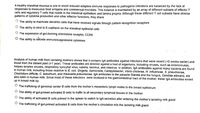
Phlebotomy Essentials
6th Edition
ISBN: 9781451194524
Author: Ruth McCall, Cathee M. Tankersley MT(ASCP)
Publisher: JONES+BARTLETT PUBLISHERS, INC.
expand_more
expand_more
format_list_bulleted
Question
Please explain why

Transcribed Image Text:A healthy intestinal mucosa is one in which induced adaptive immune responses to pathogenic infections are balanced by the lack of
responses to innocuous food antigens and commensal microbes. This balance is maintained by an array of different subsets of effector T
cells and regulatory T cells that reside in the intestinal epithelium and lamina propria. Although these different T cell subsets have diverse
patterns of cytokine production and other effector functions, they share
O The ability to inactivate dendritic cells that have received signals through pattern recognition receptors
O The ability to bind to E-cadherin on the intestinal epithelial cells
O The expression of gut-homing chemokine receptor, CCR9
O The ability to setrete immunosuppressive cytokines
Analysis of human milk from lactating mothers shows that it contains IgA antibodies against infections that were recent (<3 weeks earlier) and
those from the distant past (>1 year). These antibodies are directed against a host of organisms, including viruses, such as enteroviruses,
herpes simplex viruses, respiratory syncytial virus, rubella, reovirus, and rotavirus. In addition, IgA antibodies against many bacteria are found
in human milk, including those reactive to E. coli, Shigella, Salmonella, Campylobacter, Vibrio cholerae, H. influenzae, S. pneumoniae,
Clostridium difficile, C. botulinum, and Klebsiella pneumoniae. IgA antibodies to the parasite Giardia and the fungus, Candida albicans, are
also seen in human milk. Since most of the
up in breast milk by:
infections were localized in the gastrointestinal tract of the mother, these IgA antibodies ended
The trafficking of germinal center B cells from the mother's mesenteric lymph nodes to the breast epithelium
O The ability of gut-primed activated B cells to traffic to all secondary lymphold tissues in the mother
O The ability of activated B cells primed in the spleen to switch to IgA secretion after entering the mother's lactating milk gland
O The trafficking of gut-primed activated B cells from the mother's circulation into the lactating milk gland
Expert Solution
This question has been solved!
Explore an expertly crafted, step-by-step solution for a thorough understanding of key concepts.
This is a popular solution
Trending nowThis is a popular solution!
Step by stepSolved in 3 steps

Knowledge Booster
Similar questions
- Please don’t reject this question. Thank you. Read the article "Between Male and Female" about intersex and trans osteology. Why do forensic anthropologists have difficulty with non-binary designations? Be specific.arrow_forwardhttps://assignment.itslea https://assignment.itslear x 9 https://assignment.itslear x PDF Reader- View, Ec signment.itslearning.com/mvc/Attachment/Get?Fileld%-DM4lwUXm6r06na1JFB4B7TvjP7UpLpDF%2f%2bbc8wkWTVJCCC %2f e Unit_Practice Problems and Homework_Incomplete Do... Saved to itslearning v P Search (Alt + Q) Layout References Review View Help O Editing Roman 12 A A A EEEE AaBbCc AaBbCc AaBbCc No Spacing ab x, x Aa A Normal Heading 1 Ec Paragraph Styles Font A cattle breeder knows that the hornless condition (H) is dominant over horned (h). He mates a heterozygous hornless cow who is roan colored with a horned roan bull. What types of offspring would be expected from this cross? Give the probability of each. 6.arrow_forwardJessica is 5'5 and 145lbs 1)Calculate her BMI. To receive credit for your answer show your work. 2)arrow_forward
arrow_back_ios
arrow_forward_ios
Recommended textbooks for you
 Phlebotomy EssentialsNursingISBN:9781451194524Author:Ruth McCall, Cathee M. Tankersley MT(ASCP)Publisher:JONES+BARTLETT PUBLISHERS, INC.
Phlebotomy EssentialsNursingISBN:9781451194524Author:Ruth McCall, Cathee M. Tankersley MT(ASCP)Publisher:JONES+BARTLETT PUBLISHERS, INC. Gould's Pathophysiology for the Health Profession...NursingISBN:9780323414425Author:Robert J Hubert BSPublisher:Saunders
Gould's Pathophysiology for the Health Profession...NursingISBN:9780323414425Author:Robert J Hubert BSPublisher:Saunders Fundamentals Of NursingNursingISBN:9781496362179Author:Taylor, Carol (carol R.), LYNN, Pamela (pamela Barbara), Bartlett, Jennifer L.Publisher:Wolters Kluwer,
Fundamentals Of NursingNursingISBN:9781496362179Author:Taylor, Carol (carol R.), LYNN, Pamela (pamela Barbara), Bartlett, Jennifer L.Publisher:Wolters Kluwer, Fundamentals of Nursing, 9eNursingISBN:9780323327404Author:Patricia A. Potter RN MSN PhD FAAN, Anne Griffin Perry RN EdD FAAN, Patricia Stockert RN BSN MS PhD, Amy Hall RN BSN MS PhD CNEPublisher:Elsevier Science
Fundamentals of Nursing, 9eNursingISBN:9780323327404Author:Patricia A. Potter RN MSN PhD FAAN, Anne Griffin Perry RN EdD FAAN, Patricia Stockert RN BSN MS PhD, Amy Hall RN BSN MS PhD CNEPublisher:Elsevier Science Study Guide for Gould's Pathophysiology for the H...NursingISBN:9780323414142Author:Hubert BS, Robert J; VanMeter PhD, Karin C.Publisher:Saunders
Study Guide for Gould's Pathophysiology for the H...NursingISBN:9780323414142Author:Hubert BS, Robert J; VanMeter PhD, Karin C.Publisher:Saunders Issues and Ethics in the Helping Professions (Min...NursingISBN:9781337406291Author:Gerald Corey, Marianne Schneider Corey, Cindy CoreyPublisher:Cengage Learning
Issues and Ethics in the Helping Professions (Min...NursingISBN:9781337406291Author:Gerald Corey, Marianne Schneider Corey, Cindy CoreyPublisher:Cengage Learning

Phlebotomy Essentials
Nursing
ISBN:9781451194524
Author:Ruth McCall, Cathee M. Tankersley MT(ASCP)
Publisher:JONES+BARTLETT PUBLISHERS, INC.

Gould's Pathophysiology for the Health Profession...
Nursing
ISBN:9780323414425
Author:Robert J Hubert BS
Publisher:Saunders

Fundamentals Of Nursing
Nursing
ISBN:9781496362179
Author:Taylor, Carol (carol R.), LYNN, Pamela (pamela Barbara), Bartlett, Jennifer L.
Publisher:Wolters Kluwer,

Fundamentals of Nursing, 9e
Nursing
ISBN:9780323327404
Author:Patricia A. Potter RN MSN PhD FAAN, Anne Griffin Perry RN EdD FAAN, Patricia Stockert RN BSN MS PhD, Amy Hall RN BSN MS PhD CNE
Publisher:Elsevier Science

Study Guide for Gould's Pathophysiology for the H...
Nursing
ISBN:9780323414142
Author:Hubert BS, Robert J; VanMeter PhD, Karin C.
Publisher:Saunders

Issues and Ethics in the Helping Professions (Min...
Nursing
ISBN:9781337406291
Author:Gerald Corey, Marianne Schneider Corey, Cindy Corey
Publisher:Cengage Learning